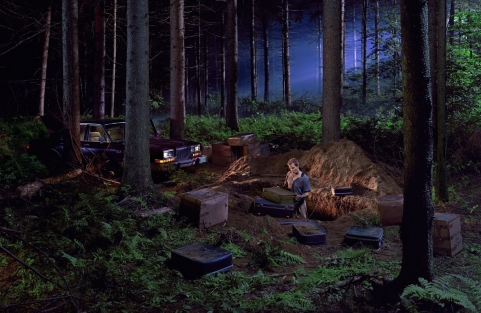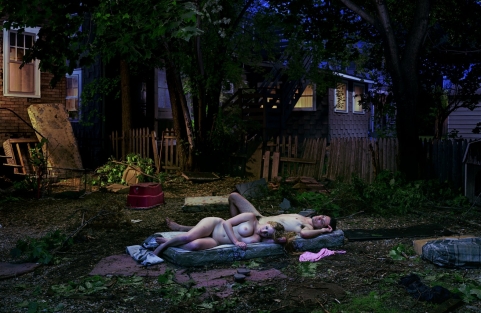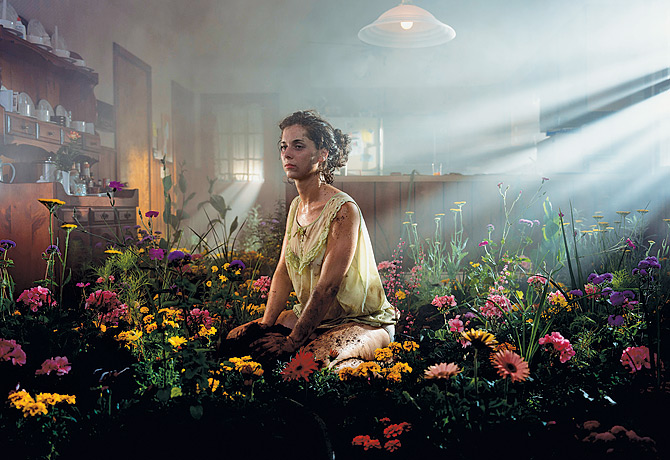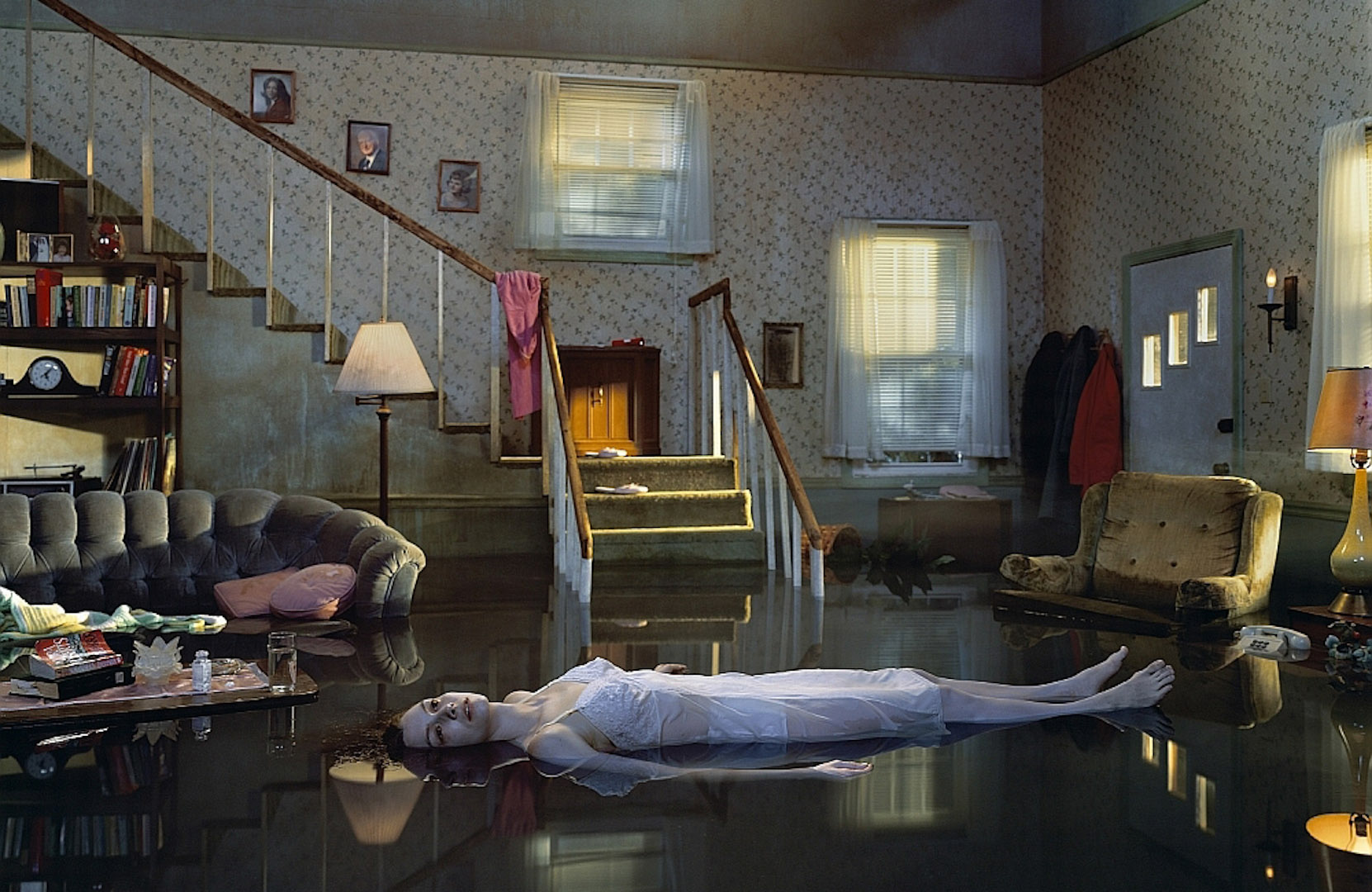
Papiers
« Je me suis intéressé au flou qui existe entre la réalité et la fiction, la nature et l’artifice, la beauté et la décadence. »
« I looked at the blurred lines between reality and fiction, nature and artifice, and beauty and decay. »
Gregory Crewdson





Né à Brooklyn en 1962, ce virtuose de la photographie réinvestit dans son travail, et non sans un certain brio, anecdotes névrotiques et récits oniriques des patients de son psychanalyste de père.
Non content de travailler le registre cinématographique, s’entourant d’équipes de cinéma, production et postproduction, son travail évoque vraisemblablement la peinture réaliste, d’Edward Hopper principalement, partageant avec le peintre un silence expressif, duquel émanent tensions, angoisses et mouvements de l’âmes, et au cinéaste David Lynch bien entendu – pour son imagerie quelque peu surréaliste et surtout onirique, où la narration est parfois difficilement lisible mais très esthétique.
Car si le conscient reconstitue – autant que faire se peut – l’image du rêve, ne lui restant à l’esprit qu’une ou deux images, accompagnée d’une atmosphère, du sentiment quelconque du rêveur au réveil , Crewdson ici reproduit chaque élément à la manière d’une scène de studio de cinéma, depuis l’image telle que l’artiste la conçoit jusqu’au tableau final, ayant nécessité une équipe digne des plus grands studios de cinéma.
Dans les compositions de l’artiste, tout est construit, voire reconstruit : les villes, ses rues, ses bois, les façades ou intérieurs des logements jusqu’à la lumière du ciel, chaque élément est recomposé depuis des souvenirs d’enfance de l’artiste, de ces récits tel qu’enfant il les entendaient furtivement à travers la porte du cabinet de son père, jusqu’aux seules images mentales qui ont pu résister au temps et qu’il choisit aujourd’hui de représenter. Décors, effets spéciaux, éclairages, se prêtent à cet exercice, documentant à travers une esthétique cinématographique la quiétude et l’inquiétude du monde du rêve.
La profusion de détails – faisant figure de preuves – et d’éléments informatifs, tranche littéralement avec la photographie à laquelle nos yeux sont accoutumés, à savoir des espaces épurés et lisse, des images saisies au vif et des personnages en mouvement là où chez Crewdson ces figures hiératiques invitent au décryptage et au songe éveillé. Ses photographies sont d’un autre genre. Elles sont l’irreprésenté par excellence, le fuyant, passant des vapeurs d’un sujet endormi à la fugacité de son éveil et de sa vision quittant peu à peu l’oeil de l’esprit appesanti pour renouer avec la concrétude de l’existence éveillée.
![]() Born in Brooklyn in 1962, this virtuoso of photography reinvests in his work, and not without a certain brio, neurotic anecdotes and dreamlike tales of the patients of his father psychoanalyst.
Born in Brooklyn in 1962, this virtuoso of photography reinvests in his work, and not without a certain brio, neurotic anecdotes and dreamlike tales of the patients of his father psychoanalyst.
Not content with working on the cinematographic register, surrounded by film, production and post-production teams, his work evokes presumably realistic painting, mainly by Edward Hopper, sharing with the painter an expressive silence, from which emanates tensions, anxieties and movements of the souls, and to the filmmaker David Lynch of course – for his somewhat surreal and above all dreamlike imagery, where narration is sometimes difficult to read but very aesthetic.
For if consciousness reconstructs the image of the dream with difficulty, remaining to mind only one or two images, accompanied by an atmosphere, any feeling of the dreamer upon awakening, Crewdson here reproduces absolutely every element in the manner of a scene from a film studio, from the image as the artist conceives it to the final table, requiring a team sign of the largest film studios.
In the artist’s compositions, everything is built and even reconstructed: the cities, its streets, its woods, the facades or interiors of the dwellings until the light of the sky, each element is reconstituted from childhood memories of the artist, from these narratives such as a child he could have heard furtively through the door of his father’s psychoanalysis cabinet, to the mental images that have been able to resist time and which he now chooses to represent. Decorations, special effects, lighting, lend themselves to this exercise, documenting through a cinematic aesthetic, the tranquility and anxiety of the dream world.
The profusion of details – evidence as evidence – and informative elements, literally contrasts with the photograph to which our eyes are accustomed, namely clean and smooth spaces, seized images and moving characters where on Crewdson’s works, these hieratic figures invite the deciphering and the awakened dream. His photographs are of a different kind. They are the irrepresented, fleeing from the vapors of a sleeping subject to the fugacity of his awakening and his vision gradually leaving the eye of the weighed mind to reconnect with the concreteness of an awaken existence.










Généralement réalisées en studio, ces photographies ne sont donc en rien improvisées : les scènes sont travaillées comme de véritables compositions picturales, où chaque détail possède son sens, de manière intrinsèque mais aussi extrinsèque, au sens où le moment choisi, celui du rêve et de la situation chimérique représentée, éveille chez le regardeur un élan certain vers une volonté d’identification, une mémoire, une projection, depuis le travail de l’artiste jusqu’aux tréfonds de l’intime.
L’univers onirique de ces séries photographiques est le lieu de la narration certes, mais aussi et surtout d’un certain malaise propre au rêve et à son image, entre aurore, nuit et crépuscule, entre matinées ensommeillées d’angoisses, sommeil profond et éveil délicat. Il n’est qu’à prêter attention aux visages des figurants, tour à tour fantomatiques, absents, hagards, pour sentir le malaise envahir n’importe quel regardeur. Malaise qui rend avide de déchiffrer l’enjeu, tantôt pour se libérer d’un conflit latent, tantôt pour saisir l’essence de la composition.
Une composition donc et non une complète narration, un instant figé sur la surface photosensible de l’appareil, faisant miroir à ces autres images fugaces figées dans l’oeil d’une mémoire qui semble plus trahir l’éveillé que le renseigner. Images qui parviennent donc furtivement à la conscience une fois sortie de la torpeur de ce long sommeil, et desquelles il s’agit de se délivrer, de donner sens ou d’oublier, prenant alors le risque que les scènes réapparaissent la nuit venant. Des images où les détails fusent mais interrogent davantage qu’ils n’informent. Laissant alors au regardeur ou au rêveur, le soin de ressasser jusqu’au sens occulté par l’éveil.
« Comme une histoire figée à jamais entre l’avant et l’après, demeurée toujours irrésolue. » Gregory Crewdson
Crewdson donne à voir, et d’une fabuleuse manière, une Amérique de la middle classe, en proie aux rêves les plus fantaisistes et non moins lugubres, où le bleu du ciel noircit par la nuit fait référence à cet ailleurs que constitue le sommeil. Où ces nuits inquiétantes, ces rêves difficilement descriptibles de rêveurs anonymes, que l’oreille de son père avait déjà probablement du chercher à détailler. Ces récits de patients, dont les rêves traquaient alors l’essence de la névrose, dans ces détails insignifiants mais non moins virulants dont le photographe s’empare dans ces compositions.
Cet ésotérisme de l’image, dans la lignée de Jeff Wall, aux mises en scènes au moins aussi minutieuses, exigeantes et précautionneuses, témoignent d’une intensité bien spécifique au monde du rêve, de la névrose, accentuée par un certain mystère émanant de ces constructions bien particulières que sont les photographies de Gregory Crewdson.
© Photographies Gregory Crewdson
![]() Generally, these photographs are in no way improvised: the scenes are worked as real pictorial compositions, in which every detail has its meaning, intrinsically but also extrinsically, in the sense that the chosen moment, that of the dream and the chimerical situation represented, arouses in the viewer a certain impulse towards a desire for identification, a memory, a projection, from the work of the artist to the depths of the intimate.
Generally, these photographs are in no way improvised: the scenes are worked as real pictorial compositions, in which every detail has its meaning, intrinsically but also extrinsically, in the sense that the chosen moment, that of the dream and the chimerical situation represented, arouses in the viewer a certain impulse towards a desire for identification, a memory, a projection, from the work of the artist to the depths of the intimate.
The oneiric universe of these photographic series is the place of narration, but also and above all, a certain uneasiness peculiar to the dream and its image, between dawn, night and twilight, between sleepy moments of sleep, deep sleep and delicate awakening. It is only to pay attention to the faces of the extras, alternately ghostly, absent, haggard, to feel the discomfort invade any looker. This discomfort makes us eager to decipher the stakes, sometimes to free ourselves from a latent conflict, sometimes to grasp the essence of the composition.
A composition, therefore, not a complete narrative, a moment fixed on the photosensitive surface of the camera, mirroring those other fleeting images frozen in the eye of a memory that seems to betray the awakened rather than to inform it. Images that reach the consciousness once they are out of the torpor of this long sleep, and from which it’s a question of freeing ourselves, of giving meaning or of forgetting, taking then the risk that the scenes reappears at night coming. Images where details spark but interrogate more than they inform. Leaving then to the viewer or to the dreamer, the care of reasserting until the hidden sense, by the awakening.
« Like a story that is forever frozen in between moments, before and after, and always left a kind of unresolved question. »
Gregory Crewdson
Crewdson shows, in a fabulous way, an America of the middle class, a prey to the most fanciful and no less lugubrious dreams, where the blue sky blackens by night refers to that elsewhere that constitutes sleep. Where these disturbing nights, these dreams, hardly descriptive of anonymous dreamers, which the ear of his father had probably already had to seek to detail. These narratives of patients, whose dreams were then tracing the essence of neurosis, in these insignificant but no less virulent details of which the photographer seizes in these compositions.
This esoteric image, in the line of Jeff Wall, with at least as meticulous, exacting and precautionary staging, testifies to intensity very specific to the world of dreams and neurosis, accentuated by a certain mystery emanating from these particular constructions, which are the photographs of Gregory Crewdson.
© Photographs Gregory Crewdson












